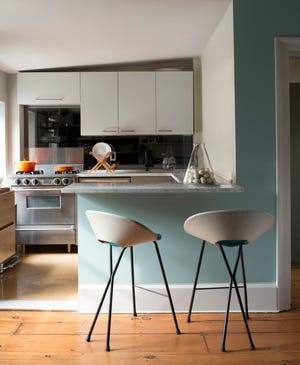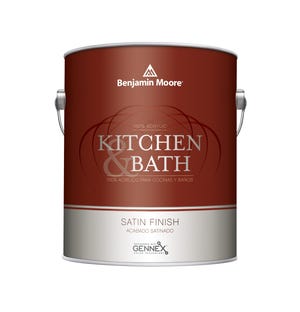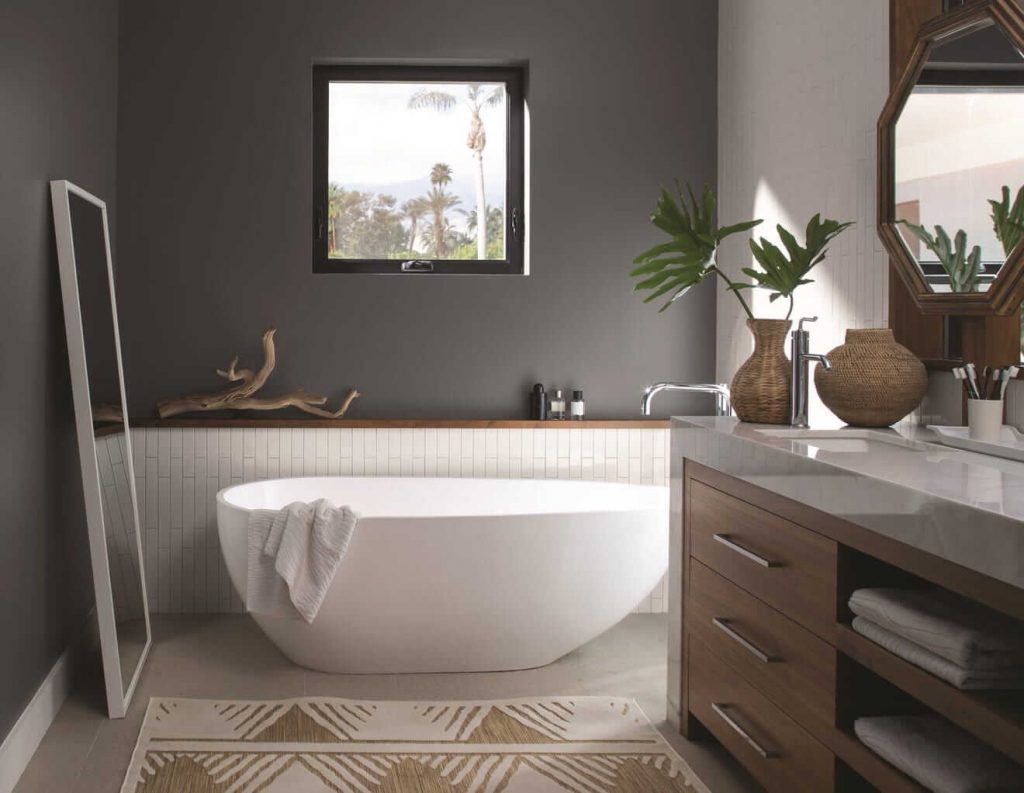A professional shares his top tips for painting any room of a home — even the kitchen.
Painting a room in your home — or even just an accent wall or two — can feel daunting if you’re doing it yourself. But with the right tools and know-how, you can not only get the job done, but you can do it so well that the smooth, perfect result will look like you hired a seasoned professional to step in.
In the Q&A below, Jeff Spillane, Benjamin Moore’s senior manager of product training implementation, answers commonly asked questions about which type of paint to choose, what equipment is best, and how to prep for and execute the task itself.
With his tips, you’ll be painting like a pro in no time.
Q: What are the different kinds of paint finishes, and how do I know which one to use?
A: A great quality about Benjamin Moore paint is that all of our finishes are highly durable, so you don’t have to be tied to the old rules, e.g., you can only use a high-gloss finish in bathrooms, never use a matte finish in a high-traffic area, etc. Now, you can use any finish in any room of the house. It all depends on the look you want to create.
To give an idea of the differences among sheens, a matte finish may appear soft and almost velvety while being forgiving to wall imperfections. A higher-gloss finish on the wall will be more dramatic and reflect more light; however, be sure that your walls are in great condition, because the higher the gloss level, the more you’ll accentuate imperfections in the wall. Luckily, selecting a finish can be a decision made around aesthetics, since great durability is present across all our products and finishes.
Q: What type of paint should I use in a kitchen?

A: Kitchen walls are generally exposed to more moisture than other rooms in the home. Benjamin Moore has products that are specifically formulated for these environments, including Aura Bath & Spa Waterborne Interior Paint. This paint is designed to achieve exceptional durability, color retention and mildew resistance in high-humidity environments.
Q: What are the essential steps of a do-it-yourself paint job?
A: Here are some general tips and techniques to help you pull off a professional-looking paint job:
• Do proper preparation. Ensure walls and surfaces are clean, dusted, nonglossy and in good condition before you prime or begin taping.
• Choose your tools wisely. Small rooms can feel gigantic when it comes to painting, especially if you’re using a brush. A roller will do a better job than a brush in less time, and, for more advanced painters, sprayers are an option. It’s also important to use high-quality products, as choosing a less expensive option may also mean sacrificing the quality, ease of application and impact on the end result.
• Cut in the edges and baseboards. Use a small, angled brush to paint around door frames, ceiling edges, corners and baseboards.
• Paint like a pro. Once you’ve cut in the edges, paint from the ceiling to the baseboard for a smooth finish. Using an extension pole will help you do so faster and without needing to go up and down a ladder.
• Don’t work too hard. Most premium paints today flow on very easily. When rolling, let the roller do the work. There is no reason to put a lot of pressure on the roller.
• Know when to reload. With most quality paints, you will be able to make two to three ceiling-to-floor passes before having to reload the roller with paint. You will see when you are running out of paint and need to reload.

Q: What’s the best way to paint over a dark color?
A: Painting over a dark hue is easy if you prep properly. Start by priming over the dark hue, then apply two coats of the desired color. Be sure to allow the primer coat to dry completely before applying the first coat of color. For dramatic color changes, we suggest using Benjamin Moore Aura Interior Paint. Aura delivers rich color and extreme hide in fewer coats.
Q: Is there a rule of thumb that tells me how much paint I need? Any tips for storing touch-up paint?
A: The pros recommend 1 gallon for every 400 square feet. Covering textured, rough or unprimed surfaces may require more. Plan ahead, and you can avoid running back and forth to the store with a paint swatch in your hand.
Tip: A small amount of paint left in a gallon can easily harden due to the air in the can. Take leftover paint, transfer it to a smaller container, and store it upside down so no air can get in.
Q: Should I wash rollers or brushes before storing them if I’m continuing the job the next day?
A: If you are going to take a break from painting, wrap your brush and roller — handle and all — in plastic wrap, and store them in the refrigerator until you’re ready to start painting again. This will keep them fresh for when you’re ready to resume the paint job.
Q: Is there a trick to using painter’s tape so it doesn’t pull paint away?
A: Prep work is critical to ensuring a perfect paint job. In addition to repairing holes and cleaning and priming surfaces, one of the most important steps is to tape off areas to ensure clean, crisp lines. To prevent bleeding, paint over the edge of the tape with the color that is already on the wall.
Always refer to the manufacturer’s instructions regarding removal, as not all tapes are created equal. You can remove tape once you have completed the painting. To remove the tape without jeopardizing the paint, gently pull it away from the wall at a 45-degree angle. Be careful not to pull it too quickly, for the tape could rip or pull paint from the wall.
Q: Do you have any unique tips or suggestions for touching up with paint?
A: Use different materials, such as cotton swabs for small, fine touch-ups. For larger areas, start by touching up with a brush, then work the paint away from the area and feather it out.
Q: Can I fix a stain, a nick or a smudge of dirt without repainting the entire wall? If so, how?
A: The sooner you can address it, the easier it will be to clean. To remove everyday marks, use a clean cellulose sponge with a little bit of warm water. Use a soft, circular motion, wait for it to dry, and see if it’s clean. If the dirt is still evident, repeat the process using a dab of dish detergent, and wipe the area dry with a clean sponge. Try to wash only the stained area, keeping the surrounding area from becoming wet.
Q: Is it OK to use a latex paint over an oil-based paint? What about vice versa?
A: It is OK to paint a latex paint over an oil-based paint. In order to do this, you will need to prep the surface as usual, as well as sand all of the gloss areas. Using a primer such as Benjamin Moore Fresh Start High-Hiding All Purpose Primer will help to assure good adhesion during this process. Although it is very uncommon, painting an oil-based paint over a latex paint would follow the same preparation process.
Q: What is the No. 1 mistake people make when painting?
A: Many consumers — and sometimes even the pros — overlook the obvious step of getting advice from their paint retailer. Every job has unique aspects that an experienced associate can help sort out.

 Interior Paints
Interior Paints Exterior Paints
Exterior Paints Primers
Primers Stains & Clears
Stains & Clears
 Paint Brushes
Paint Brushes Paint Roller
Paint Roller Paint Trays & Liners
Paint Trays & Liners
